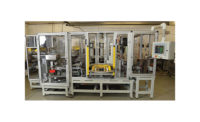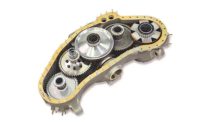Manufacturing Software
Aerospace Supplier Deals With High-Mix Production
Software enables Ancra Aircraft to optimize its assembly process by replacing text-based work instructions with animated, model-based, visual instructions.

Each year, 60 million metric tons of freight are transported around the world by air, and that amount is expected to increase. Air freight is typically used to transport fragile items, perishable goods, time-sensitive goods and temperature-controlled cargo.
Ensuring all that freight gets to its destination quickly and safely is the business of Ancra Aircraft. The Southern California company manufactures products for loading and securing cargo in commercial and military aircraft. Its products include anchor plates and tracks, galley hardware, panel stanchion fittings, nets and straps, and seat attachments.
Ancra also makes entire loading systems. Since the introduction of its first system in 1982, Ancra has delivered more than 1,600 main deck cargo loading systems, and today has more than 1,250 systems in operation in the global commercial fleet of 1,980 freighter aircraft. In 2021, Ancra delivered main deck cargo loading systems for 15 different platforms and routinely introduces three to five new cargo loading system products each year.
Many of the company’s products are built for specific aircraft, customers and applications. In fact, Ancra has some 500 different products in its catalog, and that poses a significant challenge on the shop floor. When some products are produced in low volumes and at irregular intervals, it’s easy to forget how they are made.
 With BuildOS, Ancra reduced the time required to create work instructions from several days to just a few hours. Photo courtesy Dirac Inc.
With BuildOS, Ancra reduced the time required to create work instructions from several days to just a few hours. Photo courtesy Dirac Inc.From CAD Files to Work Instructions
To help assemblers do their work effectively and efficiently, Ancra uses BuildOS from Dirac Inc.
With BuildOS, engineers drop in a CAD file, and the software automatically generates path plans, sequences assembly steps, produces 3D renderings and animations, and generates text for each instruction. Interactive animations bring assembly steps to life, improving the understanding of operators and engineers and reducing assembly errors.
The software serves as a single source of truth, capturing and linking work instructions, expert notes, tool requirements, and safety precautions directly to parts and steps. Design updates are automatically reflected in the work instructions.
At Ancra, the technology has improved standardization, enhanced communication between design and assembly teams, and reduced the amount of time needed to create work instructions.
Assembly processes are no longer dependent on manually created instructions, giving Ancra the ability to decrease lead times, reduce administrative burden, and expand production flexibility.
The digital and animated work instructions generated by BuildOS reduce a company’s reliance on the tacit knowledge of assembly technicians. These skills are learned through experience and often go undocumented. Independence from tacit knowledge allows for increased flexibility in resource scheduling and ensures a more consistent knowledge base is shared among the assembly workforce.
Lack of standardization can increase the risk of bottlenecks, complicate quality assurance, and impede continuous improvement efforts. By standardizing the creation and use of work instructions, technicians are easily able to follow the assembly process steps, leading to an increase in first-pass yields, a reduction in quality control interventions, and lower overall costs associated with quality rejections.
 With BuildOS, engineers drop in a CAD file, and the software automatically generates path plans, sequences assembly steps, produces 3D renderings and animations, and generates text for each instruction. Photo courtesy Dirac Inc.
With BuildOS, engineers drop in a CAD file, and the software automatically generates path plans, sequences assembly steps, produces 3D renderings and animations, and generates text for each instruction. Photo courtesy Dirac Inc.First Call to Roll-out in Six Weeks
Dirac’s BuildOS platform was implemented at Ancra with an accelerated timeline, moving from initial engagement to full roll-out in just six weeks. With a hands-on approach, Dirac’s team conducted an on-site kickoff to ensure Ancra could realize immediate benefits from the new software. Within the first two weeks, Ancra began generating work instructions and quickly integrated BuildOS into its assembly stations, transforming workflows and reducing reliance on manual processes.
Ten weeks after launch, Dirac’s team returned to assess the impact of the software on the shop floor. The demonstrated results allowed Ancra’s management to triple their seat count, expanding usage across departments.
Ancra’s adoption of BuildOS has transformed its assembly processes, moving from text-based instructions to a model-based system that optimizes and reinforces precision and efficiency. The implementation has delivered immediate operational benefits.
With BuildOS, Ancra reduced the time required to create work instructions from several days to just a few hours, seeing nearly 95 percent efficiency gained in some cases. One engineer noted, “A work instruction that used to take three to four days to generate using traditional methods now takes me one to two hours.”
BuildOS enables engineers to quickly draft instructions, gather real-time input from assembly teams, and make rapid adjustments, enhancing both speed and clarity.
BuildOS has also enabled Ancra to implement standardized assembly instructions, improving consistency in tools, processes and quality. This shift helps reduce errors, improve product quality, and ensure consistent results across multiple builds, even for complex assemblies.
“It just gives a clear view of how to build this assembly, not only for one but also to repeat that process for 20 or 100 units,” said one engineer.
Shifting from static PowerPoint slides and 2D technical engineering drawings to BuildOS’s animated, model-based instructions improved communication between design and assembly teams. “Before, the best method of communicating issues or challenges was by use of a screenshot or stationary picture, but this [BuildOS] helps so much more,” shared an Ancra engineer.
This enhanced clarity streamlines the build process and shortens the new product introduction cycle by closing the feedback loop between design and build.
With BuildOS, Ancra is able to capture the essential knowledge of some of its most experienced assembly technicians in detailed, animated instructions that can be digitally copied and shared across the workforce in a single training session. This capability makes assembly methods easily accessible to any team member and ensures that critical knowledge on some of Ancra’s most complex assemblies is retained within the company for future projects.
Furthermore, as Ancra captures additional business and expands its workforce to accommodate increased demand, new team members can be onboarded more easily.
Finally, BuildOS provides Ancra with a new level of visibility into production metrics, allowing engineers to analyze performance at both the station and assembly levels. These granular insights are invaluable for identifying improvement opportunities in the assembly process, enabling manufacturing engineers to spend less time on manual time studies or shadowing technicians and more time devoted to continuous improvement and optimizing production processes. This data-driven approach is already helping Ancra mitigate potential bottlenecks quickly and incorporate real-time feedback to continuously improve processes in ways that result in direct customer benefits.
For more information, visit www.diracinc.com or visit the company’s booth at The Assembly Show South April 15-16 at the Music City Center in Nashville, TN.
ASSEMBLY ONLINE
For more information on digital work instructions, visit www.assemblymag.com to read these articles:
Visual Work Instructions and the Paperless Factory
Looking for a reprint of this article?
From high-res PDFs to custom plaques, order your copy today!





